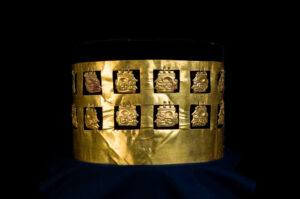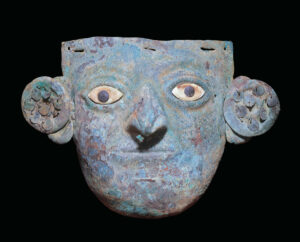

The British Museum announced that a landmark loan of ancient objects will travel from Peru to the British Museum for a major new exhibition on the ancient cultures of the South American country. Over 40 remarkable objects – some dating from over 3,000 years ago – will come to the British Museum in London from nine museums across Peru. Most of them have never travelled to the UK before.
They will go on show alongside around 80 other pieces from the British Museum’s collection in Peru: a journey in time (11th November 2021 – 20th February 2022), a special exhibition exploring the thousands of years that humans have lived in the remarkable landscapes of the Andes mountains and beyond. It is the first major exhibition the British Museum has ever staged on Peru. It coincides with the 200th anniversary of the country’s independence and is supported by PROMPERU.

From the early culture of Chavin in 1200 BC, up to the fall of the Incas in AD 1532, the exhibition will chart the rise and fall of six little known and yet extraordinary societies. Visitors will discover how people thrived in one of the most challenging and geographically diverse regions in the world, adapting to landscapes ranging from arid deserts along the Pacific coast, high mountains across the Andes and tropical forests in the Amazon in the east.

Cecilia Pardo, co-curator of Peru: a journey in time said, “While the Incas are one of the most well-known civilizations from Peru, they were actually relatively recent in terms of the long history of this region. We’ll be taking visitors back many thousands of years earlier, to show how the extraordinary past cultures of Peru were shaped by unique ways of living within the landscapes of the central Andes, one of the cradles of world civilization. They’ll discover the story of how these ancient Peruvian societies had unique approaches to economy, gender, agriculture, power and beliefs, and how they thrived against the odds right up until the Inca conquest by the Spanish. It will be eye-opening and will challenge common Western assumptions about how societies are constructed.”

Highlights among the objects coming from Peru include a stunning 2,500-year-old gold headdress and pair of ear plates which were part of an elite burial found at the site of Kuntur Wasi, Cajamarca. They are decorated with embossed motifs of human faces with feline fangs and snakes’ appendages. Also making the journey to the British Museum is a striking ceremonial drum from around 100 BC – AD 650 featuring a depiction of the capture of defeated enemies in ritual combat, one of the principal scenes of the Nazca people’s worldview.

The oldest object on loan will be a ceremonial vessel from the Cupisnique culture, which flourished along what is now Peru’s northern Pacific coast and is thought to date from up to 1200 BC. It is in the shape of a contorted human body, possibly representing someone born with a disease which causes symptoms such as loose joints and unusual flexibility, which was a revered ability in this culture.

Hartwig Fischer, Director of the British Museum, said: “A single step through the front doors of the British Museum is always the first step on a journey, and with this exhibition we invite visitors to travel through the history of one of the most captivating regions in the world. The scale of the generous loan of ancient objects from museums in Peru is unprecedented and a landmark opportunity to see them here in the UK. The fascinating range of material on display collectively challenges perceptions of how the world can be viewed and understood. We are grateful for the support of PROMPERU for making it all possible.”


The exhibition will progress chronologically through six sections and will bring the past into the present. The first, Living Landscapes, will explore the way Andean people have adapted to the difficult environment in the region. It will show how for Andean people, nature itself is a living being, sustaining all life and woven into shared belief systems where the natural and supernatural worlds are intimately connected. Visitors will then discover Early cultures and the Chavin (1200–500 BC), before the following section looking at life and death in the desert and how the Paracas and Nasca peoples lived along the south coast of Peru, one of the most arid places on the planet.
The next step on the journey will focus on the Moche (AD 100–800) and the Chimu, (AD 1000–1400) who dominated along the coast and inland valleys of northern Peru. This is followed by a section looking at the two great empires of the highlands of the Central Andes, the Wari (AD 600–900) and Inca (AD 1400–1532). The exhibition’s journey ends with a look at the Andean legacy, and how Peru today reflects a combination of cultures, religions and transformations from the past 3,000 years.

Peru: a journey in time is organized with the Museo de Arte de Lima, Peru, one of the most important museums in the country. The other lenders from Peru are: Ministry of Culture of Peru; The Gartner Collection; Fundación Temple Radicati – Universidad Nacional Mayor de San Marcos; Complejo Arqueológico El Brujo, Fundación Augusto N. Wiese; Museo “Santiago Uceda Castillo” – Proyecto Arqueológico Huacas de Moche, Peru; Museo Kuntur Wasi; Museo Larco, Lima, Peru; Museo Nacional de Arqueología, Antropología e Historia del Perú; Museo Textil Precolombino Amano– Lima-Perú.
Amora Carbajal, Executive President at PROMPERU, said: “As a promotion agency, PROMPERU’s goal is to foster the country’s culture and exciting and diverse tourism destinations. We are delighted to partner with such a renowned institution as the British Museum and bring together our countries through the exhibition Peru: a journey in time. We aim to continue developing this relationship and hopefully venturing into new partnerships with the Museum in the future.”
Alberto Rebaza T, President of the Board of Trustees, Museo de Arte de Lima, Peru, said: “The exhibition Peru: a journey in time is a unique opportunity for the millions of people that visit the British Museum to get close to, through a fresh and modern look, the vast cultural richness of Perú, one of the cradles of world civilization, and to its millenary traditions and knowledge which are still alive throughout time.”
More information can be found on the website of the British Museum.
Some important artworks from ancient American were on display in The Met in 2018.
If you are interested in Peru’s more recent (and numismatic) history? Here you can read more about coins from Peru.
The history of South America can also be told by the coins from the Lissner collection.



